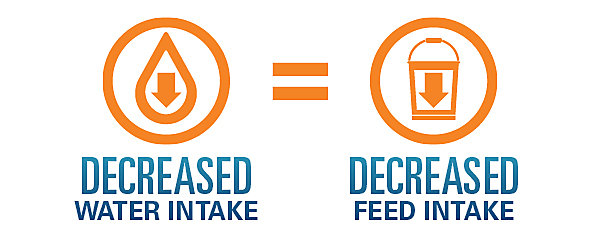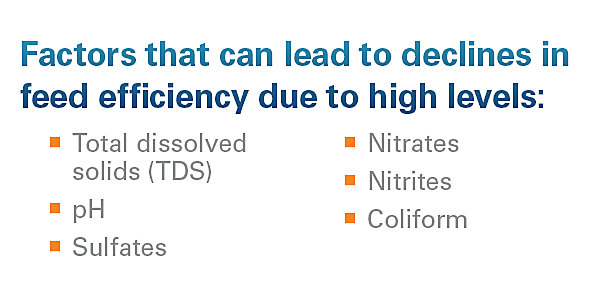Even the slightest imbalance in these components can cause nutrient deficiencies, gastrointestinal problems and other ailments that can contribute to a lag in feed efficiency, health and overall productivity. Those consequences, as well as when and how they manifest in an animal’s life, make it important to account for water when providing for any swine herd or poultry flock.
You are viewing United States
- United States
- Canada
- Mexico
- South America
- EMENA
- Sub-Saharan Africa
- Russia
- South Asia
- Asia Pacific
- China
A global presence, with local expertise. Visit our regional sites:
- United States
- Canada
- Mexico
Popular Searches
- Animal Nutrition & Health
- Don't Let Unclean Water Rob Livestock Performance
Don't Let Unclean Water Rob Livestock Performance
Add a Water Acidifier to Balance pH, Minerals and Other Compounds.
Water is water, right?
Wrong.
When it comes to the performance of a production herd or flock, the source, quantity, quality and composition of water can have a major impact on how animals perform. Not only should water be available in sufficient quantities, but it should have the right balance in pH and minerals and other components in order to maximize digestive function, gut health and overall animal performance.

What is "Clean" Water?
By many measures, water quality can vary widely, and it can have some serious effects on animal health. The vast majority of an animal’s body is comprised of water, but the implications of unclean water can be more profound on younger animals, according to Kemin Technical Services Manager Tom Marsteller.
“Water quality and quantity are key for optimal animal performance because water is the most important nutrient for animals. As a percentage of body weight, young animals have a higher percentage of body mass as water versus adult animals. That makes water especially critical for young animals,” Marsteller said. “There is a direct relationship between water and feed intake. As water intake is decreased, feed intake will also likely decline. Feed intake is imperative for profitable animal performance.”
“Clean” water for livestock is, like that for human consumption, free of foreign material. It’s next to impossible to draw water from a source that is free of any foreign material, whether organic like bacteria or inorganic like minerals. However, some foreign materials are more harmful than others; for example, high levels of any of these materials can lead to declines in feed efficiency:
- Total dissolved solids (TDS)
- pH
- Sulfates
- Nitrates
- Nitrites
- Coliforms

While there are specific testing protocols for these materials, the first step in determining the basic cleanliness of your water is a simple one.
“Would you drink from the same water source as your livestock or poultry? If no, then why not?” Marsteller said. “Water tests can be utilized to determine if the water source is acceptable. Many state laboratories will test water for a nominal fee to determine quality based on measures like total dissolved solids, pH and nitrates. Also, test the water source at least yearly to be assured of quality water for your animals. Water sources may range from rural water districts to on-site wells or pond water. Some of these sources may be challenging animals’ water intake.”
The Role of Delivery Systems
Sometimes, all it takes is a look or smell to determine if your water supply isn’t clean. When hydrogen sulfides are in excessive concentrations because of bacterial growth inside a water line, for example, water typically has the odor of rotten eggs. Rust inside water lines and waterers can indicate high iron content. Heavy scale buildup on water lines can be a sign that pH is high and calcium and magnesium are building up. A quick inspection of watering systems is a good first step in determining if any of these conditions are potentially causing a drag on animal performance, Marsteller said.
“These conditions inside the pipeline that delivers water to animals may impact both quality and quantity,” he said. “This is very important, especially as summer months approach and the animals’ demand for water increases.”
In many cases, an unclean water source or supply can cause animal performance drags that may be more difficult to diagnose, especially in larger barns and facilities with multiple livestock water sources. Regularly inspecting your watering systems can help ensure it isn’t the culprit of animal performance.
“The water quality and cleanliness may be different at various locations at the animal facility. Sourcing acceptable water and keeping the acceptable water free from contamination is key for livestock and poultry performance,” Marsteller said.
The Connection Between Water and Stress
While the cleanliness of water can have a considerable impact on overall animal health, so too can the general availability of water — especially at critical times. Any condition or life stage that causes animal stress can be intensified when the right amount of clean water is not available. Those points of stress can adversely affect animal performance by weakening the tight junctions in gastrointestinal epithelial tissue, which can open the door to other health problems.

“Animal movements, dietary changes and other stressors can impact gut health,” Marsteller said. “Weaning animals from mother’s milk is the best example of both a movement and dietary stressor. During this time, ensuring water quality and quantity is critical for the young animal’s performance.”
The Function of Acidifiers
Preventing weakened gut health, whether caused by unclean water or the absence of clean water during times of high environmental stress for animals, can be prevented by adding an acidifier to water systems. A water acidifier like Kemin KEM SAN® can lower pH levels and help balance gastrointestinal bacteria levels, removing a key barrier to feed consumption and lowering the incidence of gut health challenges brought on by unclean water.
“A water acidifier like KEM SAN is beneficial at weaning because it allows the young animal time to transition their stomach acidity from high pH, due to the previous milk diet, to a lower pH. Lower pH levels in the stomach keep bacterial populations low, preventing enteric challenges,” Marsteller said. “KEM SAN acidifies water to a pH of 5.0 and thus will act as an antibacterial administered via water. Another critical time is during dietary changes. Many changes occur in both poultry and swine as they shift from a nutrient-dense diets to a common corn and soybean-based diet. This is another excellent time to administer KEM SAN to the young, growing animals.”
Part of a Long-Term Strategy
Integrating an acidifier like KEM SAN into a watering system is part of an integrated long-term strategy that can help animals overcome the adverse effects of consuming unclean water. The first step in that strategy is to test water systems for imbalanced pH and foreign materials. Handheld pH meters and pH strips are easy ways to test water in a barn or building and can yield immediate results, so you know how much acidifier to add to a watering system. As a rule of thumb, Marsteller said water with a pH of seven or higher and magnesium levels above 60 parts per million (PPM) can lead to scale and film buildup inside water systems, which can both lead to gut health problems as well as impede animals from getting the quantity of water they need. This is especially important when moving animals between barns or introducing a new group of animals into a facility.
“Since water is the most important nutrient to animals, it is critical that you know the water quality and measure the water quantity delivered to livestock and poultry. Acidifiers like KEM SAN are helpful tools to keep the water lines clean. KEM SAN is also an excellent tool to use in helping young animals start on feed and during dietary and movement stress periods the growing period,” Marsteller said. “The use of KEM SAN to remove the biofilm from water lines is an excellent management tool to use when cleaning and disinfecting barns for a new group of animals. Starting a new group of animals with clean water lines and waterers will increase water intake of the young animals entering the facility. Increased water intake will lead to increased feed intake. Cleaning water lines ensures that adequate water supply is being delivered to the animals and the biofilm will not then plug the water lines as water demands increase with animal weight. This is especially important during summer so that pens of animals are not water deprived during the summer season.”
Have a Question?
If you have a question about our products or services, or just want more information, fill out the form below and someone on our team will be in contact with you.
Products
Careers
Careers
- California Residents
- California Supply Chain Act
- Email Disclaimer
- GDPR Personal Data Addendum
- General Terms & Conditions for Vendors
- Global Environmental Policy Statement
- Indirect Cost Estimates
- Kemin Terms & Conditions
- Modern Slavery Act Transparency Statement
- Privacy Policy
- Sitemap
© Kemin Industries, Inc. and its group of companies All rights reserved. ® ™ Trademarks of Kemin Industries, Inc., USA
Certain statements may not be applicable in all geographical regions. Product labeling and associated claims may differ based upon government requirements.
You are viewing United States
- United States
- Canada
- Mexico
- South America
- EMENA
- Sub-Saharan Africa
- Russia
- South Asia
- Asia Pacific
- China
A global presence, with local expertise. Visit our regional sites:
- United States
- Canada
- Mexico
Privacy Policy
By browsing this site you permit us and our partners to place identification cookies on your browser and agree to our use of cookies for marketing. Review our cookies policy for details.
Thank you for visiting Kemin.com.
Your questions and feedback are important to us. Let us know how we can help you learn more about Kemin, our products, our services or our website.
Interested in starting a career with Kemin?

